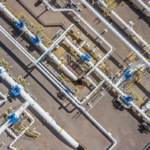Introduction
In this article, we will provide a brief overview of process control optimization, a critical step in achieving safe and efficient control of your system. The information provided is applicable to a wide variety of fluid energy processes, including petroleum and natural gas pipelines.
What is Process Control Optimization?
In a typical pipeline operation, fluid flow and pressure can be controlled by injection and delivery process control valves (PCVs), and in some cases pump variable frequency drive (VFD). In the case of a PCV, valves at both the upstream and downstream pump stations control flow to ensure pressures stay within an acceptable range and can react swiftly to pressure disturbances. In the case of pump VFD control, pump speeds are dynamically adjusted to maximize efficiency and produce the optimal discharge pressure/head.
In either case, valve actuation and pump speed are most often controlled using what is called a closed loop control system, which measures a process variable (e.g. pressure, flow rate, or temperature), compares it to a desired setpoint, and modifies the equipment’s behaviour accordingly.
The three basic components of closed loop control system are:
- Sensor, which measures the process variable (e.g. pressure transmitter or flow meter transmitter at a location of interest)
- Controller, which compares the measured variable with one or more desired setpoints (e.g. maximum acceptable pressure at inlet of a terminal) and outputs a signal to meet the desired setpoint. The industry standard for control is a Proportional-Integral-Derivative (PID) control which, if tuned correctly, can provide robust performance in a wide variety of operating conditions
- Control Element, which accepts the signal from the controller and adjusts the system accordingly (e.g. actuates PCV open percentage or adjusts VFD pump speed)
Optimizing a control loop by system tuning can enable you to maximize system efficiency, safely react to pressure disturbances, protect expensive equipment, and maintain a reliable operation with minimized downtime. Tuning involves modifying the PID controller parameters to achieve these goals, both through computer flow simulations and real-world field testing — requiring an analytical approach, experience, and process knowledge
Why Do We Need Process Control Tuning?
There are several risks with an improperly tuned process control system. If a system responds to a system or setpoint change too slowly, there is the potential for conditions to exceed safe limits. For example, pipeline terminals typically have a high manifold shutdown logic built into their control valve to protect the terminal equipment (which is often lower pressure rated) by closing the main pipeline delivery PCV. This response requires quick and accurate closure of the valve based on a sensor downstream – too slow and pressures could quickly rise in the terminal and damage equipment or exceed piping limits.
If a setpoint responds too quickly, premature wear of equipment may occur – a valve may react excessively to small fluctuations in pressure or cycle indefinitely as it fails to react appropriately. In extreme cases, it may cause a controller to go “off the rails” and make process conditions worse as it progressively over-reacts. Poor response can also lead to cavitation downstream of a valve as pressures drop below the fluid vapor point, potentially generating severe pressure waves and equipment stress/vibration.
What Steps Are Involved in Improving Process Control?
In this article, we will focus primarily on steps taken in PCV design and improvements, as these are the most ubiquitous in the energy industry.
Valve Selection
Using a computer model and simulation of a given system, potential valves may be considered based on several criteria. Control valves must have sufficient capacity such that pressure drop is sufficiently low at maximum flow rates. Valve travel range should be maximized, such that the valve is not utilizing only a small portion of its range to control flow (between min and max open fraction conditions). As well, consideration of the potential for cavitation, noise, and cost should be included in this analysis. Different valve types will have very different performances, depending on the process.
Linearization
Due to the inherent nature of valve design, how actuation of a valve impacts flow conditions varies tremendously on the open percentage of a valve — when the valve is <50% open, changes in percentage will often result in minimal changes to pressure drop; when the valve is >50% open, changes in percentage will have more drastic changes to pressure drop. This can be compensated for by controller output linearization.
Linearization results in a more consistent response throughout the entire range of a valve. Computer simulations can verify this responsiveness and the result of a linearization block in the control loop.
Field Tuning
The final step that is required in process control optimization is field tuning. As real-life processes are complex and models rarely fully capture equipment complexities or sensor accuracy, field testing and tuning of controller parameters are used to adjust the previously obtained computer simulated results.
An experienced Venturi field technician logs data from the terminal while performing what’s called a bump test. In its simplest form, bump testing involves changing the setpoint of a valve in steady-state operation and observing the response as the controller attempts to adjust the PCV actuator to reach the new setpoint. Depending on the results of this test, a controller’s response may be adjusted to react to the modified setpoint more appropriately. A good response depends on the process, control room demands, and engineer/technician experience.
Five Keys to Process Control Success?
Finally, we’ll leave you with five overall keys to achieving process control success, all of which Venturi’s team can help assess and improve in your system. They are:
- Good Process Design resulting in a controllable process. Some important issues include PCV size, inherent characteristics, actuator resolution and speed of response, pressure transmitter reliability and bandwidth.
- Good Control Strategy Design that supports the process objectives, compensates for known disturbances, produces linear process dynamics, and is understandable to the operators.
- Good Control Loop Tuning Fast, stable tuning of the pressure controllers. The P, I and D tuning constants fundamentally determine how the controller responds to a disturbance or setpoint change
- Good Loop Health the sensor, controller, and control valve need to function at specification targets. The sensor needs to be accurate and fast responding. The actuator must be able to position the valve with good resolution and must move the valve quickly.
- Good Troubleshooting skills from the process engineer, E&I mechanic, and operators to quickly diagnose and fix control loop problems.
Closing
We hope this has been an informative overview of control loop performance and the expertise that is required to achieve successful process control. Obviously, there is much more behind the scenes to designing and implementing process control – the best way to learn more is to reach out and discuss your process needs with our team.


